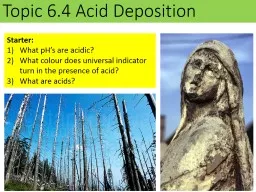

Starter What pHs are acidic What colour does universal indicator turn in the presence of acid What are acids Rain is naturally slightly acidic pH 56 Caused by carbon dioxide in the air dissolving into the water forming ID: 907993
Download Presentation The PPT/PDF document "Topic 6.4 Acid Deposition" is the property of its rightful owner. Permission is granted to download and print the materials on this web site for personal, non-commercial use only, and to display it on your personal computer provided you do not modify the materials and that you retain all copyright notices contained in the materials. By downloading content from our website, you accept the terms of this agreement.
Slide1
Topic 6.4 Acid Deposition
Starter:What pH’s are acidic?What colour does universal indicator turn in the presence of acid?What are acids?
Slide2Slide3Rain is naturally slightly acidic pH 5.6Caused by carbon dioxide in the air dissolving into the water forming carbonic acid.
However, when sulfur and nitrogen oxides dissolve in the rain they form sulfuric and nitric acid and can have a very low pH (1-3)
pH scale is logarithmic, pH1 is x10 more acidic that pH 2, and x100 stronger than pH 3
Slide4What are the sourcesSulfur is a common impurity in coal.There is some in oil too.
Main source is coal fired power stations.Reacts with the oxygen in the air when the fuel is combustedNitrogen and oxygen react together in engines due to the high temperatures.This forms nitrogen oxides.
Slide5Slide6Effects of acid depositionResearch the effects of acid deposition. Use the 6 areas below as your main research focus:
Aluminium ionsLichensNutrient removal effect on soil fertilityBuildingsPeat bogsHuman health
These can be organised into different categoriesDirect effect – the actual damage the acid does.
Indirect toxic effect
– e.g. aluminium ions dissolving.
Indirect nutrient effect
– e.g. leaching of nutrients.
Slide7Slide8Acid rain is regional (not global) problemThe pollutants do
travel, but not over huge distances.They dissolve in rain before they get too far.Dry deposition – close to the source, generally the primary pollutants.Wet deposition – longer distances, generally the acids.Areas downwind of major industrial regions are most affected.Scandinavian forests and lakes affected by British, Polish and German emissions by a south-western prevailing wind.
Slide9CASE STUDYResearch the effect of acid deposition and intergovernmental agreements or legislation and their effectiveness
In 3 groups you are going to create a poster to show the impact and pollution management strategies in one of the cases below:Canada affected by acid deposition from the USA.
Sweden and Norway affected by acid deposition from Poland, Germany and UK.China
Slide10Reducing the effects of acid depositionUse the video to find out about the following techniques:Liming lakes to neutralise acidity.
Pre-combustion (before burning) techniques.End of pipe measures (after burning).Of course we could always reduce our use of fossil fuels to help solve this problem……..Nuclear power? Electric cars?
Slide11Replace, regulate, restore.As with all pollution related topics in ESS you need to be able to evaluate pollution management strategies.Using the help table I have given you (also next slide), answer the following long answer question:
Describe and evaluate pollution management strategies for acid deposition. (8)
Slide12Slide13can be divided into preventative or curative;preventative includes reducing fossil fuel emissions;e.g. by encouraging alternative energy sources such as solar;public transport schemes;reduction in energy demand for electricity by increasing energy
efficiency;these address the cause of the problem so are arguably more effective;but are expensive and unpopular e.g. leading to job losses inthe coal industry;may be currently impractical e.g. alternative energy suppliescannot replace the amount of energy we currently get from fossil fuels;
curative involves responding to the effects of the problem;e.g. spraying forests/liming lakes;clean up measures at points of emission e.g. desulfurisation in coalfired power stations;these measures may be cheaper in the short- term but do notaddress the cause of the problem and are therefore not a long-term
solution;
8 max